Adam Yamey's Blog: YAMEY, page 9
July 12, 2025
Displaying and selling works of art in London for forty years
VICTORIA MIRO WAS born in London in 1945, Her parents, who were keen on cultural pursuits, saved their money and took Victoria for holidays in Italy to see art there. My parents did the same thing for me and my sibling. Victoria studied painting at the Slade School of Fine Art (at UCL), and then became an art teacher at a secondary school. In the 1970s, she married a businessman, Walter Miro. After bringing up her children for a few years, she opened an art gallery in 1985. It was in Cork Street. In 2000, she moved to larger premises near Hoxton and Old Street. The gallery is housed in a converted former furniture factory. Since then, Mrs Miro has opened another smaller gallery in Venice.
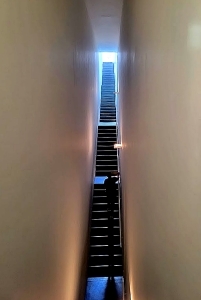
To celebrate the fortieth anniversary of her gallery, the Victoria Miro has put on a special exhibition in her London establishment. It will continue until 1 August 2025. The show includes works by many of the artists that have exhibited at Victoria Miro since 1985. They are displayed beautifully in the large galleries within the converted factory. The list of artists can be found at https://www.victoria-miro.com/exhibitions/656/ . Some of the works, for example by Paula Rego, are now old, but many of the other artworks were created especially for the exhibition.
To see the entire exhibition, you must be prepared to climb many stairs, including an impressive 72 step staircase, because some of the works are on the upper floors of the building, which have never before been used as exhibition spaces. It is worth seeing the whole show because moving through the gallery spaces allows one to appreciate the converted factory’s elegant architecture. The interior was designed by architect Michael Drain in collaboration with Claudio Silvestrin. At the rear of the building, there is a terrace beside a pond shaded by trees.
Although the works in the anniversary exhibition are wonderful, it is the gallery’s interior design that steals the show. It does not overpower the artworks, yet it does compete with them for one’s attention. I must admit that the design of the spaces and the way they interconnect fascinated me more than what was on display. Whether your interest is modern art or modern architecture, a visit to the gallery will be well worthwhile. Its precise address is 16 Wharf Road, London N1 7RW.
July 11, 2025
Sculptures hidden by the mist in Bangalore
When we arrived in Bangalore in November 2025, our friend Harsh, an architect and curator who is based in Ahmedabad, sent us a message about his exhibition in Bangalore at a gallery, of whose existence we had been hitherto unaware. The privately owned gallery is called KAASH. It is housed in a beautifully restored old-style bungalow such as were built (mostly) between the 1860s and 1930s. They are a colonial ‘take’ on English country cottages. The gallery’s bungalow at number 2 Berlie Street is complete with perfect examples of ‘monkey tops’ (screens of closely spaced vertical wooden slats placed over porches and windows).
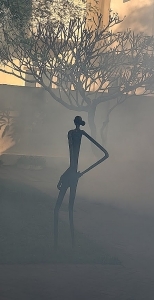
The exhibition that Harsh had curated at KAASH was a collection of contemporarily designed devotional objects, mainly diyas (oil lamps used on Hindu ceremonies). There were also some almost abstract depictions of Devi created by Jayshree Poddar, and a few items of folk art from various countries in Africa. The artworks were tastefully displayed in rooms within the bungalow.
In the garden surrounding the building, we saw several sculptures. As the sun set, a worker moved around the garden spraying a fumigating smoke that created an eery mist. The sculptures were temporarily partially hidden, becoming rather like peaks partially concealed by low clouds. Gradually, they reappeared as the insecticidal smoke dispersed. Having seen the KAASH gallery, we decided that it would become a place we visit whenever we happen to be in Bangalore.
July 10, 2025
Sunflowers on the walls in London’s Mayfair
SINCE TIME IMMEMORIAL artists have been influenced and inspired by creators who preceded them. In the case of the German artist Anselm Kiefer (born 1945), he has been both influenced and inspired by Vincent Van Gogh (1853-1890), who was born almost a century before him. Both artists have broken boundaries, and explored new ways of expressing themselves in painting. At two Mayfair galleries, White Cube (Mason Yard; until 16 August 2025) and Thaddeus Ropac (in Dover Street), you can see some of Kiefer’s paintings that illustrate his response to Van Gogh, and in particular the Dutch artist’s depictions of sunflowers and wheat fields.
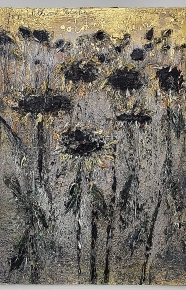 By Anselm Kiefer
By Anselm KieferAt the age of 18, Anselm Kiefer made a journey following in the footsteps of Van Gogh. The White Cube’s website revealed the route he took:
“… from the Netherlands to Belgium, Paris, and finally to Arles, where, in the final years of his life, Van Gogh created many of his most iconic works.”
It is those works painted in Arles that are reflected in Kiefer’s creations that are on display in both galleries as well as in a temporary exhibition in London’s Royal Academy in Piccadilly. Almost all of Kiefer’s images at White Cube and Thaddeus Ropac contain sunflowers and/or depictions of fields of agricultural crops. Unlike Van Gogh’s paintings, there are no human figures depicted in Kiefer’s artworks. In one of them, there is a flock of menacing looking black birds with wings outstretched. Kiefer’s crops made by sticking materials onto his canvases look much more sinister than the often-vivid depictions of agricultural landscapes created by Van Gogh. In their own ways, both Van Gogh and Kiefer portray the world as a disturbed place. In the case of the Dutch artist, this might have been due to his psychologically disturbed state of mind when he was in Arles. In Kiefer’s case, one must remember that he was born at the end of WW2 in a country devastated by conflict and the horrendous dictatorship that preceded it.
Although I am often less than convinced by pairing and comparing two artists in exhibitions such as that at the Royal Academy, but putting Vincent and Anselm side-by-side is both intriguing and appropriate. Having viewed the Kiefer works at the two Mayfair galleries, I now look forward to seeing how the Royal Academy’s curators have dealt with the relationship between the two artists.
July 9, 2025
Two swans perched on a post box in Henley-on-Thames
TODAY WE PAID a brief visit to Henley-on-Thames. As we walked along the town’s picturesque Market Place, we noticed a post box (pillar box) on the top of which there was a beautifully knitted (or crocheted) pair of swans, one a white adult and the other a grey youngster. This creation was tightly fitted to the convex top of the red post box. It is an example of a ‘post box topper’. All over the parts of England that we have visited during the last few years we have seen many examples of these handmade knitted or crocheted ‘toppers’. The swan topper in Henley is a particularly attractive example. The people who make these decorative woolly hats for post boxes are sometimes known as ‘yarn bombers’.
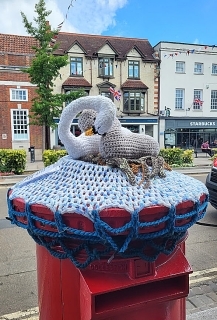
I wondered about the history of the toppers. All I could discover was in an article published online in northwichguardian.co.uk on 19 June 2021. It revealed that the Post Office:
“… first began to see these toppers in 2012 over the festive season, although this soon spread to other key times of the year such as Easter. More recently, we have noticed decorations celebrating various frontline workers during the pandemic, including postal workers.”
I first began noticing these folkloric creations in mid-2020 when the covid19 regulations were eased sufficiently to permit us to make day trips from London into the nearby countryside.
Creating toppers involves a lot of work and must surely challenge the creators’ ingenuity. Some of them are quite simple in design, but others, like the swans in the centre of Henley, are intriguingly complex. The toppers are unpretentious works of art which must bring a smile to the faces of many a passerby.
July 8, 2025
After the heatwave came the cloudburst … après moi le déluge
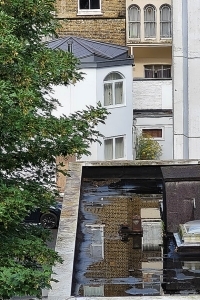
FOR OVER A WEEK at the end of June and the beginning of July (2025), temperatures in London hovered around 30 degrees Celsius. Then, it became a bit cooler, and the sky clouded over. Despite the slight decrease in temperature, the air in London remained unpleasantly humid.
Then, on Sunday the 6th of July, the heavens opened. Rain came streaming down. The downpour was as heavy as monsoon rains I have seen in India.
After less than 10 minutes, the rain ceased, there were several rolls of thunder, and the sky became blue once more.
The photograph shows the disadvantages of a flat roof. With poor drainage, it becomes a swimming pool.
July 7, 2025
Flowing through Lodon
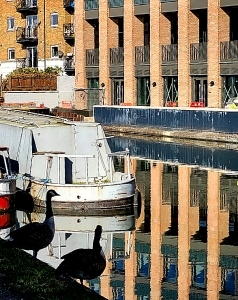 Grand Union Canal (Paddington Arm)
Grand Union Canal (Paddington Arm)See the canal
Enjoy the birds and many boats
Savour London’s sights
July 6, 2025
Walk the house on London’s South Bank
DO HO SUH is an artist who was born in South Korea in 1962. He was awarded a Bachelor of Fine Arts and Master of Fine Arts from Seoul National University, and then later, a Bachelor of Fine Arts in painting at the Rhode Island School of Design. He lived and worked in Seoul, then in New York City, and now in London. So, during his life, he has changed homes several times while moving from place to place. His exhibition that is on show in London’s Tate Modern until 19 October 2025 is called “Walk the House”. The exhibition is his artistic interpretation of what the concept of home means and of his experiences of moving from one residence to another.
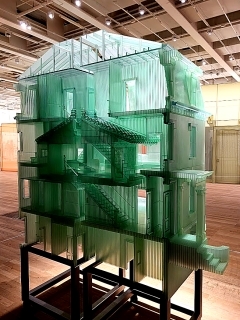 A house within a house
A house within a houseTh artist’s works in the exhibition range from sketches, paintings, and sculptures to spectacular three-dimensional installations. Some of the installations can be entered and explored by visitors. In one of them, called “Nest/s”, the artist has stitched together a series of rooms made of translucent cloth that evoke places where he has lived in Seoul, New York, London, and Berlin. Visitors walk along a tunnel from room, thus following in the footsteps of the artist as he changed homes. Another large installation that can be entered is a large room made of translucent, white polyester. To the walls of this structure, the artist has attached models of appliances and fittings that were in each of the homes he has lived. The items that have been attached have been colour coded: a different colour for each of the places in which he has dwelled. One other thing that particularly appealed to me is a translucent resin model of the house in which he lived in Providence, Rhode Island. Visible within this model there is a model of Suh’s childhood home in Seoul.
The Tate’s web page for this exhibition explained:
“Is home a place, a feeling, or an idea? Suh asks timely questions about the enigma of home, identity and how we move through and inhabit the world around us.
With immersive artworks exploring belonging, collectivity and individuality, connection and disconnection, Suh examines the intricate relationship between architecture, space, the body, and the memories and the moments that make us who we are.”
And this does well summarise what can be viewed in this exhibition, which is well worth visiting.
July 5, 2025
Somewhere snooty in Ooty (Ootacamund in south India)
ABOUT TWENTY-FIVE years ago, we spent a short holiday in the southern hill station at Ootacamund (Udhagamandalam) in India’s Tamil Nadu state. Often called ‘Ooty’, the town is the home of one of India’s most prestigious colonial-style clubs, the Ootacamund Club, which was founded in 1841. It was there that my in-laws arranged for us to stay for a few nights. Our bedroom with a working wood fireplace was comfortable enough. It reminded me of rooms in old-fashioned hotels in which I had stayed in with my parents in the English countryside in the late 1950s.
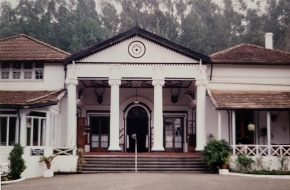
When we stayed at the club in 2000, it seemed to be quite a ‘snobby’ or ‘snooty’ place. We were travelling with our then five-year old daughter. Apart from our bedroom, there were only two parts of the club that she was permitted to enter. One was a lobby, and the other was a children’s dining room. The latter was depressing to say the least. Because we did not want to abandon our daughter, we saw little else of the inside of the club. The rest of the club house could only be entered by adults wearing appropriate clothing. For men in 2000, this included a jacket, shirt, proper shoes (not trainers or sandals) and tie. It seemed crazy to enforce such rules as we were the only people staying in, or using, the club during the off-season. I wonder if these rules have been relaxed at least a little since our visit.
It was not my first visit to Ooty. My wife and I had spent part of our honeymoon there after our marriage in Bangalore in January 1994. That time, my father-in-law had arranged for us to stay in the St Margarets guest house that belonged to the company in which he had worked, ITC. Our stay at St Margarets was not without small problems, but the place suited me much more than the hallowed Ooty Club.
July 4, 2025
History revealed at a shop in London’s Kensington
SHOPS IN LONDON’S High Street Kensington are forever changing hands. And each time a new lessee takes over a shop, he or she brings in builders to alter the shop’s appearance. Today (in July 2025), I passed a currently empty shop undergoing a change in the appearance of its façade. The front of the shop had been stripped down, and as a result the name of one of the businesses that had formerly used the premises had been revealed. The old shop sign at number 13 High Street Kensington read “Blooms (1920) Ltd.”.
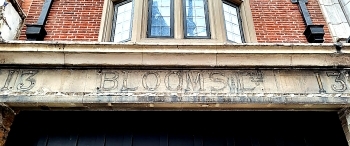
When I tried looking this up on Google, by entering various combinations of search words, I was shown a list of flower shops, none of which are at 13 High Street Kensington. And, sadly, nothing came up that revealed any information about Blooms Ltd, which had once occupied the premises. So, if anyone knows anything about the business conducted by Blooms (1920) Ltd, do please let me know.
July 3, 2025
Flames and faith
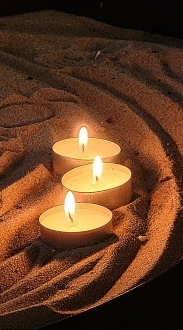
These three candles were burning in a church in Suffolk (England).
Fire and flames play significant roles in many of the world’s religions, and have done so since time immemorial.
What is it about flames that attracts the attention of so many people with widely differing beliefs?



